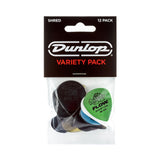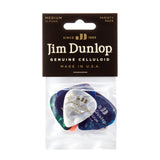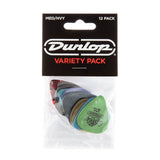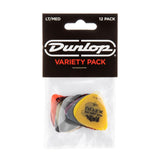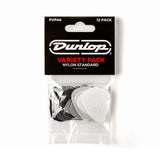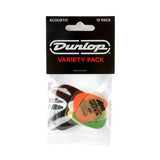Your Guitar Bridge is a supremely important bit of your instrument that plays multiple roles in its operation. It controls your action, intonation, and string alignment, as well as allowing you add texture and expression to your playing in the case of a Tremolo Bridge. This crucial bit of hardware has many variations, so as a guitarist it’s important to understand what does what, and why you would choose to have a particular bridge on your guitar.
What is a Bridge?
Traditional stringed instruments produced sound in two steps. First energy was applied to the strings, usually through picking, plucking, or bowing. But for these vibrations to be transferred to the soundboard, they required a conductor to take these a small vibration and make them audible. That’s where the humble bridge comes in. Designed as a conduit from the strings to the soundboard, the design of the bridge allowed the strings to vibrate freely, yet still carry said vibrations to the soundboard for amplification.

With Electric Guitar, the primary method for capturing sound is your pickups, but that doesn’t mean the Bridge isn’t still an incredibly important component of the instrument. It still affects the way your string vibrates, and different types of bridges have different advantages and disadvantages depending on the design.
Fixed vs Tremolo
There are lots of different types of Guitar Bridges out there, but primarily they fall into two categories, Fixed Bridges and Tremolo Bridges.
Fixed Bridges
A Fixed Bridge is termed because it is fixed to the body and doesn’t move. They fall into three typical categories, Hard Tail Bridges, Tune-O-Matic Bridges and Wraparound Bridges, each with a slightly different design. The benefit of a fixed bridge is that it offers better tuning stability due to its solid contact between the guitar body and strings. There is also some effect on the sound, as it provides better transfer of vibrations to the body of the guitar. This is why you’ll find a lot of hollow and semi-hollow electric guitars have Tune-O-Matic or Wraparound Bridges.
Tremolo Bridges
The Tremolo Bridge is called so because it allows you to add the ‘Tremolo’ effect to your playing. Although the term ‘Tremolo’ has become the popular name for these types of bridges, the effect you’re actually applying is ‘Vibrato’. ‘Tremolo’ is a steady increase and decrease in volume (think the intro to ‘Gimme Shelter’), whereas ‘Vibrato’ is an increase or decrease in pitch. Despite this factual inaccuracy we’ll stick with the more commonly used ‘Tremolo’ for simplicity’s sake. With Tremolo Bridges you get Synchronized Tremolos (aka ‘Floating Tremolos), Locking Tremolos, Bigsby Vibratos and the lesser known Duesenberg and Stetsbar Tremolos.

Most Tremolo Bridges are suspended, reducing contact with the guitar body. This affects the sound of the guitar and the resonance, as there is a lesser contact with the guitar body. However on an electric guitar the impact on your overall tone is minimal. A group of springs in the back of the guitar allows it to return to its original position, opposing the tension of the strings and allowing you create unique guitar sounds unavailable on a fixed bridge guitar.
Types of Guitar Bridge
Here are the six most popular types of guitar bridge you'll find. We've picked the three most popular types from both Fixed and Tremolo bridges to ensure an even spread. We’ve also listed the advantages and the disadvantages of them all, allowing you to discern what’s best for your needs.
Tune-o-Matic Bridge
The Tune-o-Matic Bridge was first used by Gibson on their 1953 Gibson Super 400 before appearing on the Les Paul Custom the year after. Eventually it became the standard for all Gibson guitars, replacing the Wrap-Around design. It became the standard for Gibson mainly due to the string break angle created by the Stop Bar, which offered improved sustain and excellent tuning stability.
Tune-o-Matic bridges are mounted to the guitar body with two Bridge Posts, allowing for easy adjustment to the string action, usually via a ‘slot head’ or ‘thumbwheel’. The Tune-o-Matic bridge also has individually adjustable string saddles, allowing you to intonate each string individually, ensuring they are in tune across the length of the strings. The only real downside with a Tune-o-Matic Bridge is that you can’t adjust string height individually as you can on a Hard Tail or other Tremolo Bridges, instead you can adjust either the bass or tremolo side.
Wrap Around Bridge
The Wrap-Around Bridge was one of the first types of bridges used on electric guitars and pretty much every brand has used one at some point. The original designs didn’t allow for intonation adjustments, although this has been corrected by some modern designs.
Wraparound bridges are probably the easiest to restring, making them great for beginners just getting to grips with the ins and outs of the electric guitar. However the lack of fine tuning capability can make them a hinderance at times, despite their excellent tuning stability and ease of use.
Hard Tail Bridge
The Hard Tail Bridge looks very similar to a Tremolo bridge, with individually adjustable saddles, however it is fixed to the guitar body and doesn’t move. You’ll find these on Telecasters, where the unique bridge plate design helps create that signature Tele twang, however there are a quite a few Stratocaster models that utilise them, minus the bridge plate.
Hard Tail Bridges are renowned for holding their tuning exceedingly well, and as with the Wrap Around style bridge they’re super easy to restring making them great for beginner guitars. Another benefit is that changing the bridge for an upgraded version is usually a straight swap, just a case of unscrewing the old one out and screwing the new one back in.
Synchronised Tremolo
The Synchronised Tremolo Bridge (aka the Floating Tremolo or Vintage Tremolo) is one of the most popular guitar bridges you’ll find. Typically occupying space on Stratocasters and many Strat-style guitars, the Synchronised Tremolo has an integrated bridge and tailpiece, giving it an advantage in adjustability over a Bigsby-style Tremolo. At the back of the guitar you’ll find the tremolo is held in place by 3 or 5 springs that are hooked into the guitar body, creating the tension which allows it to return to pitch.
The Synchronised Tremolo is popular because of it’s sonic versatility as well as its inherent adjustability. With individually adjustable saddles for action and intonation, getting them set up just the way you like is a breeze. Combined with the ability to manipulate pitch with the whammy bar, you can understand why these are a favourite of guitarists the world over. A Synchronised Tremolo allows you to accentuate your playing, whilst still providing reliable tuning stability, especially when combined with locking tuners.
Floyd Rose Tremolo
The Floyd Rose Tremolo Bridge (aka Locking Tremolo) is similar in design to the Synchronised Tremolo, but it features a locking nut. By keeping the strings in position at the nut, the Floyd Rose or Locking Tremolo allows you to heavily manipulate the string length, creating some wild guitar effects. This has made them a favourite of hard rock and metal guitarists, where they’re often used to accentuate guitar solos to great effect.
The stability of the Floyd Rose or Locking Trem makes it an incredibly useful tool in the right hands, but it’s definitely not for beginners. You’ll require some knowledge of the system before you can set it up properly and even changing strings can be difficult if you don’t know what you’re doing.
If you're struggling with your Floyd Rose Tremolo then feel free to check out our Floyd Rose Tremolo Set Up Guide.
Bigsby Vibrato
The Bigsby Vibrato was designed in the late 1940s and was initially used on hollow and semi-hollow body guitars. A much more subtle effect than that of the Floyd Rose Tremolo, the Bigsby has a spring loaded tremolo arm and two bars to create its effect. The first bar keeps tension on the strings whilst the second, called the ‘roller bar’, moves with the strings, as well as acting as the string anchor.
The Bigsby can be a bit marmite in terms of appearance, however for a lot of people it lends a classic aesthetic to guitars with its signature bulky design. It delivers a smooth and subtle tonal change that a lot of players prefer to the dramatic effects of a Synchronised Tremolo or Floyd Rose system. The downside of a Bigsby Vibrato is that tuning stability is not always the best, although this can be remedied with locking tuners, and for a beginner it can be difficult to change the strings with one of these installed.
If you'd like to fit a Bigsby to a guitar that doesn't currently have one, check out The Easy Way to Install a Bigsby Vibrato.
Conclusion
There are a couple of less popular bridge designs we’ve not mentioned here (the Stetsbar and Duesenberg) but for the most part these are the bridge types you’re most likely to find on your guitar. A bridge upgrade on a beginner or intermediate guitar can have a huge effect on its playability, as it’s such an integral part of the instrument. Whilst all bridge types have their advantages and disadvantages, it really depends on what you’re looking for when deciding to either change your bridge, or purchase a new guitar.
If you're in need of an upgrade check out all our Guitar Bridges.
Learn More
Get your guitar playing its best with our Guitar Setup Guide.
Make sure you've got the right strings on your guitar with our String Gauge Guide.
Understand more about electronics with our Tone Caps and Guitar Potentiometer Guides.

















